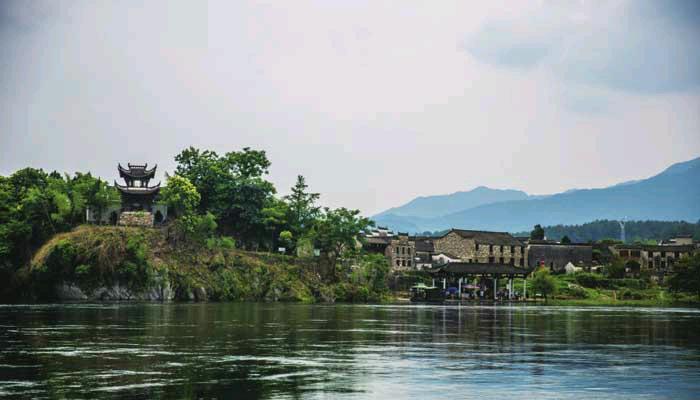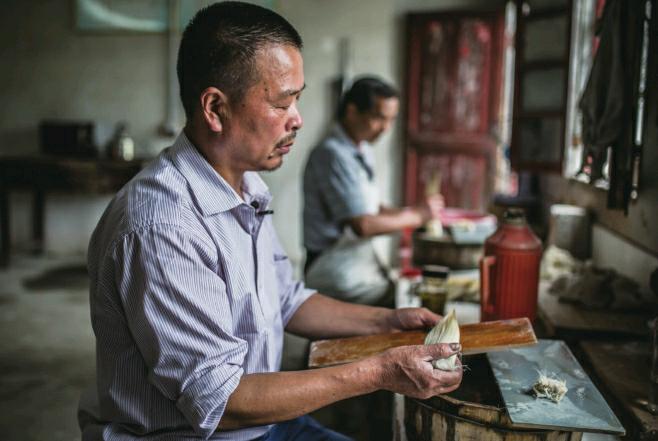Cultural Immersion
2017-08-02ByJacquesFourrier
By+Jacques+Fourrier
Rapid development and mass urbanization in China in the last 30 years have brought about massive transformation in the social fabric of the country. As China enters the “new normal” of ecofriendly and sustainable development in an innovative and service-oriented economy, a slow return to traditions and to the charms of country life is now transforming villages.
Anhui is the archetype of this new trend. Once one of Chinas poorest provinces, it is now home to a thriving tourism sector and a source of inspiration for the multitudes in search of their ancestral roots and traditions.
Back to the countryside
If Chinas urbanites once used to embrace all the trappings of the modern world, they are now increasingly eager to connect with rural life. Even foreigners are being enticed away from the cities. Better communication and transport infrastructure have accentuated this trend.
“A French family moved here a few years ago and they are even raising chickens and growing vegetables,” said a tour guide in Zhaji Village in Jingxian County, a quaint rural spot that has tapped into the huge potential of domestic tourism with great success for a decade.
Anhui Province in east China heeded the Central Governments advice before the Beijing Olympics in 2008 and has since made impressive strides in preserving its cultural heritage and developing a sustainable tourism sector. This turnaround in the provinces fortunes has two major implications: Locals have an incentive to stay in the province and make a decent living, while the prospects of a better future in an idyllic environment draw outsiders in droves to country life.
Historical villages and hamlets studding southern Anhui, which centuries ago made their fortune by trading timber, tea and salt before they sank into obscurity, are now being transformed for the better.
Longchuan in Jixi County is one of these villages blessed with an unusual bounty of fine architecture. Its Ming Dynasty (1368-1644) lavish Hu clan hall is hailed by tour guides as the finest example of its kind, while the Song Dynasty (960-1279) archway propped with rusty metal posts stands proudly at the entrance of the village as a reminder of its past glory. Locals wash the dishes or do the washing in the shallow stream snaking its way through the village.
A middle-aged man with the surname Xu said he has been selling candy bars handmade from rice flour to tourists for nearly fi ve years. The man from neighboring Zhejiang Province did odd construction jobs before setting up shop in Longchuan.
“We have tourists all year round, so we can make a decent living in a unique surrounding,” he said as lines of cap-wearing pensioners and their tour guides walked past. Among them was Liu Fengyun, a spry 65-year-old from north Chinas Tianjin. She signed up along with 20 other retirees for a five-day whistle-stop trip to Anhui. “We were in Huangshan Mountain yesterday and we want to enjoy Anhuis traditional culture as well as the beautiful scenery and the local specialties,” she explained briskly.“Tomorrow, well visit another village in Jingxian County.”
Some educated, well-off urbanites and artists have chosen to settle down in rural areas. Their arrival has contributed to the gentrifi cation of some of these villages.
Rediscovering tradition
Anhui has much more to offer to those who wish to immerse themselves into traditional culture.
The province is famous for Huangshan Mountain—named a UNESCO World Heritage site in 1990—and for its sprawling tea plantations producing some of the worlds most reputed varieties, such as Maofeng green tea and black tea in Qimen County, in the eastern part of the province.
Besides picture-postcard prettiness, Anhui has also contributed to the cultural magnificence of Chinas art of calligraphy with the “Four Treasures of the Study,”namely the brush, ink, paper and inkstone. Since the Song Dynasty, generations of masters and craftsmen in Anhui have refi ned and passed down their techniques and sometimes, their secrets.
The digital age and disaffection with traditions at one point threatened these ancient crafts. In the last two decades, the authorities have however taken a series of measures designed to protect traditional skills and established institutes, workshops and research centers to perpetuate them.
Ma Lagen is a 60-year-old craftsman from Jingxian County. He has been making Xuan brushes for 40 years. Xuan brushes are one of Chinas most prized brushes, made of goat, black rabbit and yellow weasel hair. They were especially made to cater to the needs of emperors and mandarins in ancient China. In the nondescript workshop of San Tu Xuan Bi Brushmaking Co. Ltd. in Jingxian, he repeats tirelessly the same technique day after day.
“My family has been making brushes here for as long as I can remember,” said Ma while giving the fi nishing touch to the tip of a brush. To make sure that it is both soft and fl exible, he dipped it occasionally into a bowl of agar-agar, a jelly-like substance obtained from algae. “My son has also learned the craft, so the know-how will be passed down,”he remarked.
She Zhengjun is the companys deputy general manager and Director of Xuan Brush Crafts Research Institute. “The new generation is being trained and the art of Xuan brush-making will not be lost,” he said.“Moreover, we get orders from all over the world, and our brushes are not only tools of choice for calligraphers, but also prized, desirable gifts.”
Jingxian is also home to Xuan papermaking, a technique dating from the Tang Dynasty (618-907) using the bark of the indigenous blue sandalwood. Such is the quality of this hand-made paper that a block can fetch up to several hundred dollars.
Guardians of the traditions are keeping the old skills alive, and despite harsh working conditions and years of hard toil, social recognition is a great solace to them. A museum opened in April 2016 pays tribute to their dedication and recounts the thousand-year history of Xuan papermaking in the county.
Culture-wise Anhui has much more for visitors to explore. The province is at the crossroads of philosophy and religion. It is the birthplace of Taoism, a doctrine that had a profound impact on philosophy, politics, art and literature in China, while Qingyang County, in the southernmost tip of the province, boasts one of the four sacred mountains of Chinese Buddhism, the Jiuhuashan Mountain.
Anhui cuisine has also gained a solid reputation for its Hui cuisine, one of the eight culinary traditions of Chinese cuisine. One dish, the Li Hongzhang hodgepodge, has gained international recognition after a famous late Qing Dynasty (1644-1911) offi cial baffl ed his foreign guests by seemingly cobbling together a variety of ingredients offhand but ending up creating the most delicate of recipes.
This could probably serve as a metaphor for the diversity of Anhui traditions and culture: a rich legacy and a never-ending quest for excellence.
